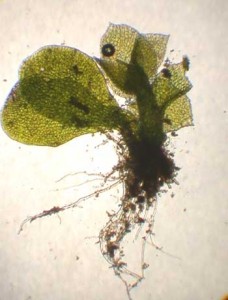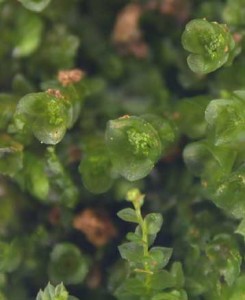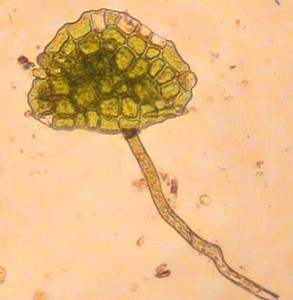Habitat
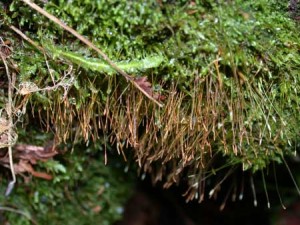 Tetraphis pellucida is commonly found on decaying wood in coniferous forests and on peaty banks.
Tetraphis pellucida is commonly found on decaying wood in coniferous forests and on peaty banks.
Protonema
Overall structure:
 The unistratose protonemal flaps arise from uniseriate and filamentous protonema. The small, green, erect flaps can be found on the surface of wood, as seen here in this picture.
The unistratose protonemal flaps arise from uniseriate and filamentous protonema. The small, green, erect flaps can be found on the surface of wood, as seen here in this picture.
The chloroplast rich protonemal flaps have uniseriate rhizoids. Furthermore, young gametophytes are initiated at the base of these flaps.
Gemmiferous Shoots
Overall structure:
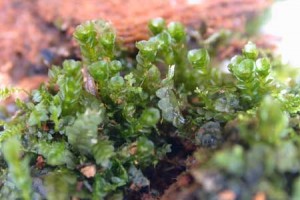 Gemmiferous shoots (gemmae-producing shoots) develop and arise from the protonemal flaps.
Gemmiferous shoots (gemmae-producing shoots) develop and arise from the protonemal flaps.
The gemmae are located at the end of the gemmiferous shoots, in a cup-shaped whorl of leaves. This shape functions as a splash-cup mechanism.
Once the gemmae are expelled from the gemmiferous shoots, if conditions are optimum, then germination will occur. Seen here in this picture is a gemma that has produced rhizoids.
Gametophyte
Overall structure:
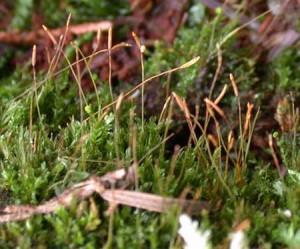 This species is a very small acrocarpous moss. It forms green, short turfs of erect and unbranched shoots.
This species is a very small acrocarpous moss. It forms green, short turfs of erect and unbranched shoots.
Leaf:
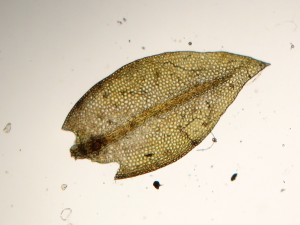 The leaves of T. pellucida are radially arranged around the stem. Note that the leaves have a costa.
The leaves of T. pellucida are radially arranged around the stem. Note that the leaves have a costa.
 Here is a cross section of the leaf. Note that the costa is multistratose whereas the lamina is unistratose.
Here is a cross section of the leaf. Note that the costa is multistratose whereas the lamina is unistratose.
Stem:
 A close look at a stem cross section reveals that this species has a central strand.
A close look at a stem cross section reveals that this species has a central strand.
Female gametophyte:
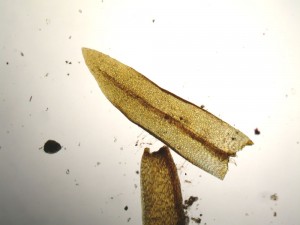 The perichaetial leaves of the archegonial plant are elongated in comparison to the other leaves found on the gametophyte.
The perichaetial leaves of the archegonial plant are elongated in comparison to the other leaves found on the gametophyte.
Male gametophyte:
 The perigonial branch can be seen in this picture along with the antheridia. It is interesting to note that if an archegonial plant is not fertilized one year, it is capable of developing a perigonial branch in the year that follows.
The perigonial branch can be seen in this picture along with the antheridia. It is interesting to note that if an archegonial plant is not fertilized one year, it is capable of developing a perigonial branch in the year that follows.
Sporophyte
Overall structure:
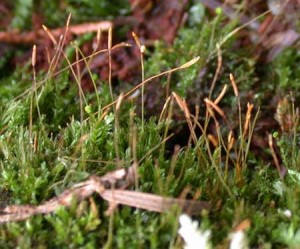 The sporophyte becomes reddish-brown as it matures.
The sporophyte becomes reddish-brown as it matures.
Sporangium:
 The sporangium has 4 peristome teeth, and these teeth are unjointed and are made of elongate cells. This condition is called nematodontous (teeth consist of whole dead cells).
The sporangium has 4 peristome teeth, and these teeth are unjointed and are made of elongate cells. This condition is called nematodontous (teeth consist of whole dead cells).
Seta:
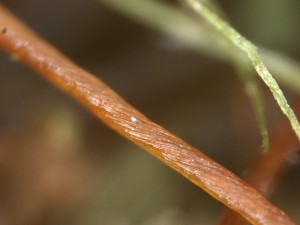 The seta of Tetraphis pellucida can be twisted, as seen in this picture. The seta, being hygroscopic, untwists when it becomes dry, and therefore aid in the dispersal of spores.
The seta of Tetraphis pellucida can be twisted, as seen in this picture. The seta, being hygroscopic, untwists when it becomes dry, and therefore aid in the dispersal of spores.

